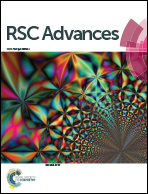Label-free detection of sulfide ions based on fluorescence quenching of unmodified core–shell Au@Ag nanoclusters†
Abstract
Based on the principle of fluorescence quenching, by the interaction between S2− ions and the Ag atoms/ions on the surface of the core–shell Au@Ag NCs, we propose a simple label-free method for the detection of S2− ions with high selectivity and sensitivity by using fluorescent core–shell Au@Ag NCs in aqueous media.


 Please wait while we load your content...
Please wait while we load your content...